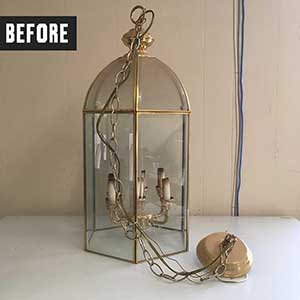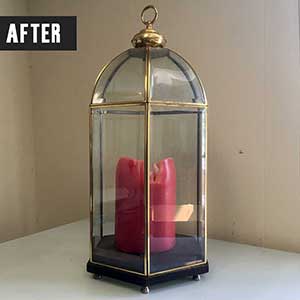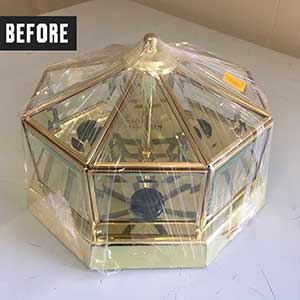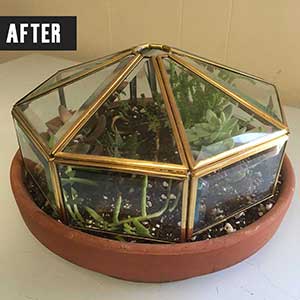These brass and glass lantern lights were easy to find in the foyers, halls, and dining rooms of 1980’s homes. Tastes in lighting might have changed, but these fixtures still have a lot of potential … even if you don’t use them as lights!
Candle Lantern
This candle lantern was created using a hanging foyer light from Community Forklift. The light sockets and central lighting column were removed, and a base created out of two pieces of scrap wood. Six salvaged dresser drawer knobs from Community Forklift were also used for decorative feet.
Outside the scrap wood, total cost for this project was only $20 ($18 for the light, $2 for the set of knobs)! It’s a fun and affordable way to create a custom candle holder. We have multiple sizes of this foyer lighting, so you could also create a family of lanterns of different sizes. They’d look great flanking a front door or lining a dining room buffet!
Terrarium
Treat your plants to some stylish new digs! This terrarium was created using a low pot and the shade from a flush-mount light from Community Forklift. If you don’t have a pot that fits the diameter of the shade, try the housewares department and look for some baking tins or serving dishes!
Before planting, it’s important to do some research on what type of environment will best suit your plant of choice. Using different soils, bases, and either closed or open lanterns will affect the conditions inside the terrarium. And if you are using multiple plants in the same terrarium, make sure they all like the same environment!
Get Creative
Visit the reuse warehouse and check out the different shapes and sizes of light fixtures that we have available. And then get creative! Could you use the tall lantern above as a terrarium for a single potted plant? Would the flush-mount light make a good votive candle holder? How else could you use these light fixtures?
***
Every time you donate or shop at Community Forklift, you’re helping us lift up local communities through reuse. We turn the construction waste stream into a resource stream for communities in the DC region – by keeping perfectly good items out of the landfill, preserving historical materials, providing low-cost building supplies, and creating local green jobs.





